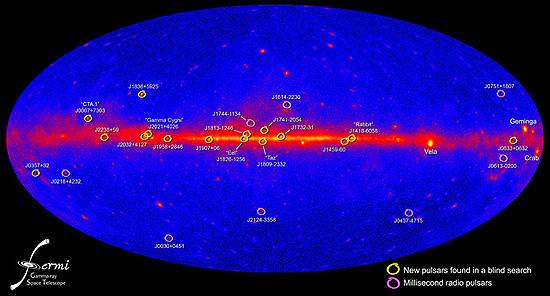[/caption]
For the first time, NASA’s Fermi Gamma-ray Space Telescope has spotted a new group of pulsars using only their gamma-ray emissions, in the absence of radio signals beamed to Earth. The 16 new objects are reported in this week’s edition of Science Express, in a study based out of the University of California in Santa Cruz.
A pulsar is a rapidly spinning neutron star, the dense core left behind after a supernova explosion. Most of the 1,800 known pulsars were found through their periodic radio emissions.
“These are the first pulsars ever detected by gamma rays alone, and already we’ve found 16,” said co-author Robert Johnson, a UC Santa Cruz physicist. “The existence of a large population of radio-quiet pulsars was suspected prior to this, but until Fermi was launched, only one radio-quiet pulsar was known, and it was first detected in x-rays.”
Of the 16 gamma-ray pulsars, 13 are associated with unidentified gamma-ray sources detected previously by the EGRET instrument on the Compton Gamma-ray Observatory. EGRET detected nearly 300 gamma-ray point sources, but was unable to detect pulsations from those sources, most of which have remained unidentified, said Pablo Saz Parkinson, also a SCIPP postdoctoral researcher and corresponding author of the paper.
“It’s been a longstanding question what could be powering those unidentified sources, and the new Fermi results tell us that a lot of them are pulsars,” Saz Parkinson said. “These findings are also giving us important clues about the mechanism of pulsar emissions.”
A pulsar emits narrow beams of radio waves from the magnetic poles of the neutron star, and the beams sweep around like a lighthouse beacon because the magnetic poles are not aligned with the star’s spin axis. If the radio beam misses the Earth, the pulsar cannot be detected by radio telescopes. Fermi’s ability to detect so many radio-quiet gamma-ray pulsars indicates that the gamma-rays are emitted in a beam that is wider and more fan-like than the radio beam.
The team identified the gamma-ray pulsars in data from Fermi’s Large Area Telescope (LAT). Marcus Ziegler, a postdoctoral researcher at UC Santa Cruz and corresponding author of the paper, said detection of gamma-ray pulsations from a typical source requires weeks or months of data from the LAT.
“From the faintest pulsar we studied, the LAT sees only two gamma-ray photons a day,” Ziegler said.
The very intense magnetic and electric fields of a pulsar accelerate charged particles to nearly the speed of light, and these particles are ultimately responsible for the gamma-ray emissions.
Because the rotation of the star powers the emissions, isolated pulsars slow down as they age and lose energy. But a binary companion star can feed material to a pulsar and spin it up to a rotation rate of 100 to 1,000 times a second. These are called millisecond pulsars, and Fermi scientists detected gamma-ray pulsations from eight millisecond pulsars that were previously discovered at radio wavelengths. Those results are reported in a second study also published in the July 2 edition of Science Express.
“Fermi has truly unprecedented power for discovering and studying gamma-ray pulsars,” said Paul Ray of the Naval Research Laboratory in Washington. “Since the demise of the Compton Gamma Ray Observatory a decade ago, we’ve wondered about the nature of unidentified gamma-ray sources it detected in our galaxy. These studies from Fermi lift the veil on many of them.”
Lead image caption: This all-sky map shows the positions of 16 new pulsars (yellow) and eight millisecond pulsars (magenta) studied using Fermi’s LAT. Credit: NASA/DOE/Fermi LAT Collaboration
Sources: Science and UC Santa Cruz, via Eurekalert.


“… detection of gamma-ray pulsations from a typical source requires weeks or months of data from the LAT.
From the faintest pulsar we studied, the LAT sees only two gamma-ray photons a day.”
I’m really curious to understand more about that!
Excellent. Should shed even more light on the nature, structure and behaviour of these exotic species.
In terms of the two photons-per-day detection – DAMN! I’m curious as to how they could possibly build up the counting statistics enough, even in months or years, to confirm that this is in fact a pulsar, let along determine it’s rotation period.
“Fermi’s ability to detect so many radio-quiet gamma-ray pulsars indicates that the gamma-rays are emitted in a beam that is wider and more fan-like than the radio beam.”
I admire the patience these guys have. 2 photons a day. wow. Perhaps, evidence for “fan-like” emission rather than a collimated beam?